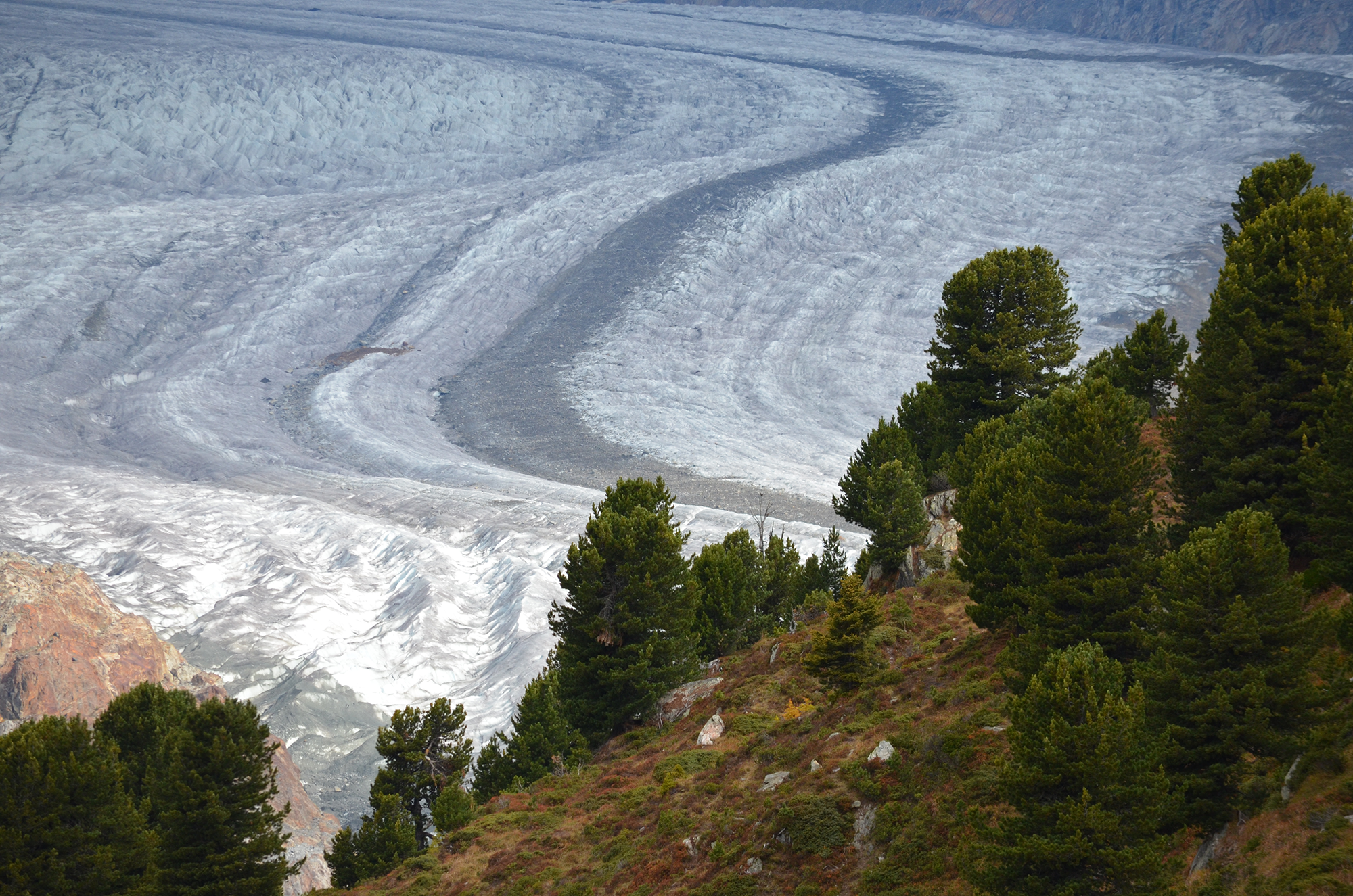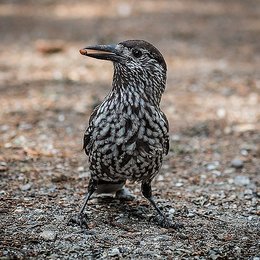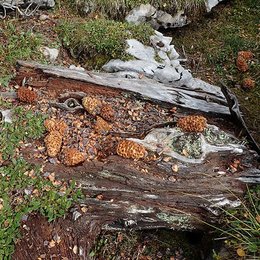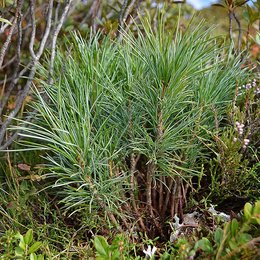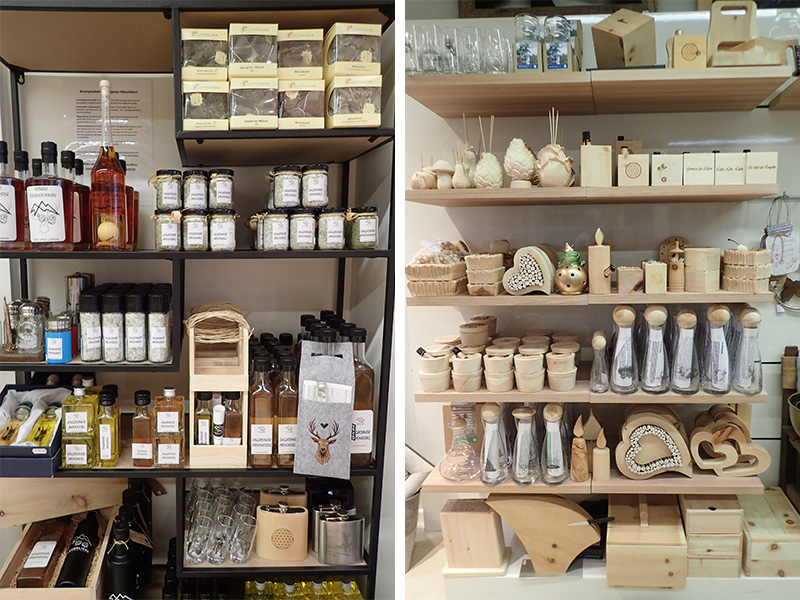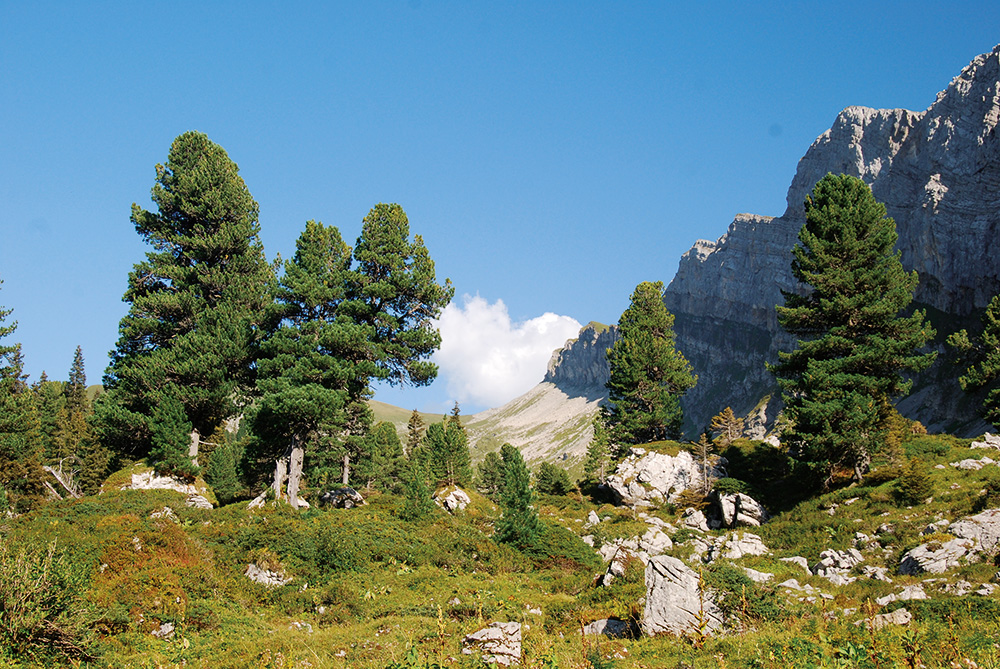The Swiss stone pine (Pinus cembra L.) stands out among the pine tree species of the Alpine region (fig. 1). It “crowns” the timberline, its altitudinal range explaining why it is sometimes also known as the “Queen of the Alps”. The stone pine also stands out for various biological characteristics (see profile). As well as its capacity for physiological adaptation, its interaction with the spotted nutcracker (Nucifraga caryocatactes) as a seed disperser is of particular note. And then the Swiss stone pine also plays an important ecological and economic role as the main tree species of the stone pine-larch forest community, especially in the Alps.
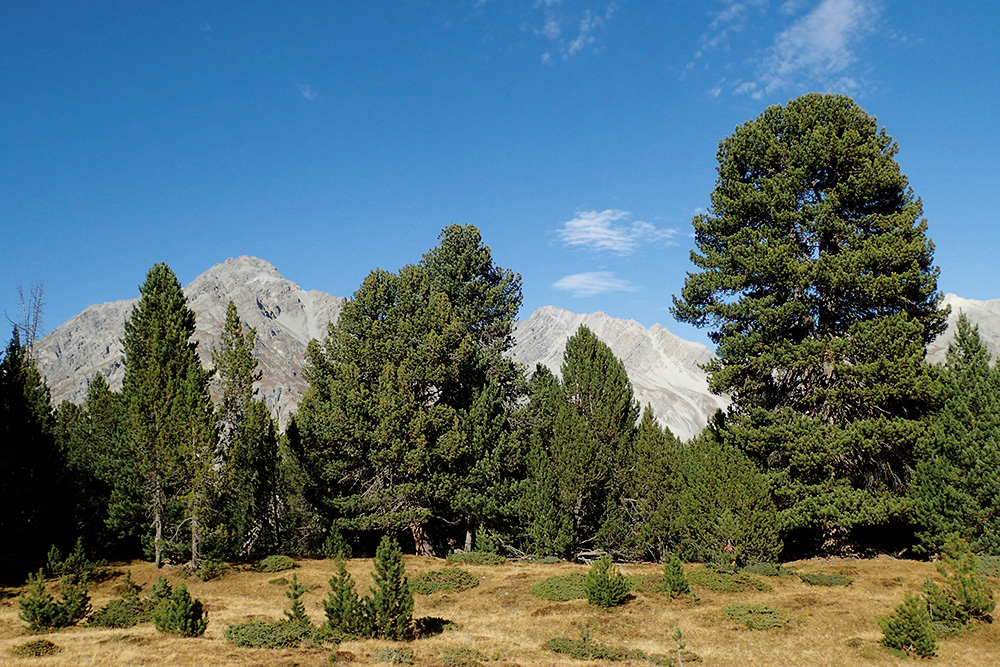
Fig. 1. Steadfast Swiss stone pines in a dynamic habitat: patchy, mixed-age stand above the Aletsch Glacier (Switzerland). Foto: Sabine Brodbeck (WSL)
Profile of Swiss stone pine
- Classification: Gymnosperms (Gymnospermae) – pine family (Pinaceae) – pines (Pinus) – Pinus cembra L.; nearest relative: P. sibirica
- Range: Alps, Carpathians
- Habitat: (Supra-)subalpine altitudinal zone, with larch (Larix decidua) and spruce (Picea abies); generally well supplied with water, acidic raw humus soils, predominantly north- and west-facing; avoids hollows
- Growth shape: upright, up to 25 m; often with multiple trunks or candelabra-shaped as a result of damage
- Age: mostly up to max. 400 years, “Methuselah” stone pines anecdotally over 1000 years old
- Reproduction: monoecious / with separate female (cones) and male inflorescences on the same plant; reproductive from about 40 years (in cultivation also earlier), seed development over two years; mature seeds weigh 150–270 mg
- Dispersal: Pollen by wind, seeds mainly by spotted nutcracker
- Identifying features: 5 needles per cluster, needles triangular in cross-section; whitish wax stripes on 2 sides; young shoots reddish-yellow and tomentose; closed, purple-tinged, rarely green cones with non-winged, hard-shelled seeds
- Occurrence in Switzerland: 5.7 million trees (>12 cm trunk diameter), 1.2 % of the number of trees nationwide; 2.9 million m³ (0.7 %) of volume of standing timber; increase of 9 % in both of these values (National Forest Inventory NFI4, 2009–2017) since NFI3 (2004–2006)
- Names: English: Swiss stone pine, arolla pine; German: Arve, Arbe, Zirbe, Zirbelkiefer, Zir(b)m; French: arole, arolle, pin cembro, pin des Alpes; Italian: cirmolo, pino cembro; Romanish: gembru, gembra, (d)schember
No Swiss stone pines without spotted nutcrackers
It is impossible not to recognise or hear the spotted nutcracker (Nucifraga caryocatactes), with its blackish brown, white-spotted plumage, its black tail with a white terminal band on the undertail, white undertail vents and characteristic, long and chisel-like beak, and its distinctive call (fig. 2).
The spotted nutcracker feeds mainly on the seeds of the stone pine. It collects them from late summer (fig. 3) onwards, and hides them in the ground as winter reserves. The bird has to find the stone pine seeds under the snow in winter and dig them out, often with a great deal of effort. The recovery rate of around 80 % is thus all the more astonishing. The seeds that remain buried are enormously important for the spread of the Swiss stone pine. However, new studies show that, contrary to popular belief, the caches are not usually created on sites that are favourable for germination.
Ultimately, the decisive factor for the Swiss stone pine is how many seeds remain in sites that are favourable for the establishment of seedlings (fig. 4). Seed caches in clearings within existing forest areas and above the tree line, as they occasionally occur, may be of great importance for the Swiss stone pine in the current context of climate change.
Colonisation history
Like all species found in the Alpine region today, the Swiss stone pine has an eventful history. The area available for the stone pine has varied constantly with the repeated advances and retreats of the glaciers in central Europe.
Fossil plant remains (pollen, macro- remains) show that the Swiss stone pine probably survived the last ice age along the central and eastern southern edge of the Alps, in the Hungarian lowlands, and around the Carpathians. Its return to the Alps was mainly westwards into the eastern Alps and northwards / westwards into the central and western Alps. The Carpathians were mostly recolonised from nearby populations.
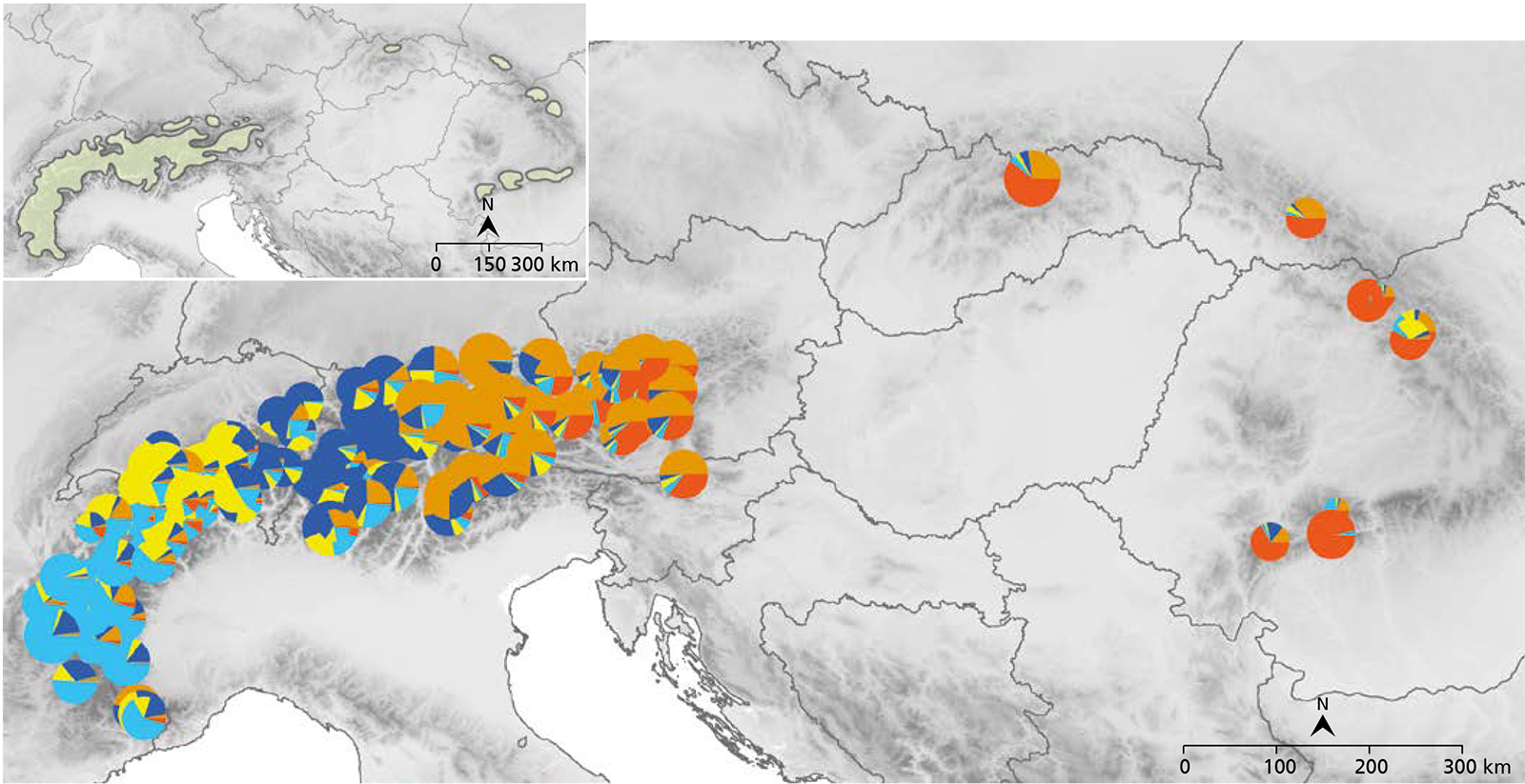
Fig. 5. Genetic structure of the Swiss stone pine in its natural range. The circles each mark a genetically investigated stand. The colours in the circle diagrams represent the proportions of each of the five genetic lineage groups. Small map: natural range of the Swiss stone pine in the Alps and Carpathians. Source: Gugerli et al. 2023, small map: Euforgen.
This history of migration to and fro is also reflected in the spatial genetic structure, which reveals five genetic lineages along the east-west axis of the Carpathians and the Alps (fig. 5). The eastern group dominates primarily in the Carpathians and is likely to have originated mainly from refugial areas close to the Carpathians; it reveals a genetic link to the eastern Alps. The three genetic groups in the western Alps became differentiated as they returned after the maximum spread of the last ice age. Two genetic groups dominate in Switzerland, corresponding respectively to the two main areas in the east and west (Engadine and Valais). Knowledge of this spatial pattern makes it possible to detect the transfer of seed over long distances, for example, or to select suitable seed sources (provenance).
Utilisation
The earliest evidence of the utilisation of Swiss stone pine comes from the Bronze Age (1400 BC). From the 16th century onwards, it is known to have been put to a variety of uses in addition to its use as fuelwood in the salt works, for example. This soft, easily workable wood was used to make utensils for mountain agriculture, such as bowls, vessels for milk, and spoons. Due to its antibacterial and insect-repelling properties, Swiss stone pine was popular for furniture used to store goods (cupboards, flour chests).
In addition to wood, forest litter was also used as fodder and animal bedding in certain regions until the middle of the 20th century. This had serious repercussions for the regeneration of the Swiss stone pine: because the raw humus layer was removed, not only the seed bed was raked off, but often also the seedlings developing in it. Out of concern for forest regeneration, litter and cone use was restricted or banned in many areas from 1900 onwards. As well as being limited by the use of litter, natural regeneration was further hampered by the hunting of spotted nutcrackers, which was financially rewarded in some regions until the 20th century.
Nowadays, more non-forestry products are being produced (fig. 6). In addition to the value chain of its products, for which no figures are available, the stone pine also has an intrinsic and above all an aesthetic value. Both these symbolic, centuries-old trees, marked by wind and weather, and the richly structured stone pine or mixed stone pine forests they form are much admired and appreciated. The quality of the stone pine landscape is an important argument used to underline the attractiveness of tourist destinations and thus for local value creation.
Seed harvesting, breeding and reforestation
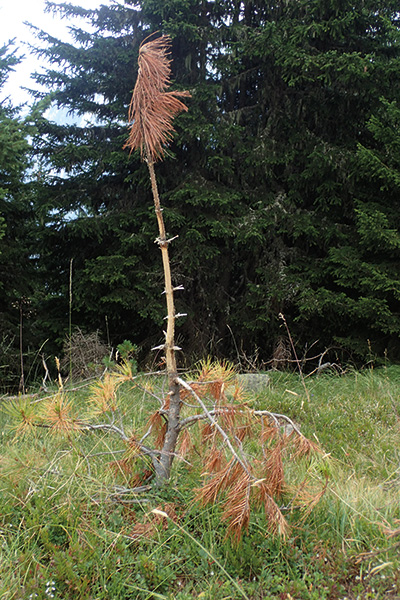
Fig. 7. Antler-rubbing and stripping damage caused by cloven-hoofed animals usually leads to the death of the young trees. Photo: Sabine Brodbeck (WSL)
The WSL Research Institute has been examining ways of promoting the Swiss stone pine in mountain forests for over 50 years. Numerous reforestation projects have been realised for this purpose and scientifically monitored for decades. Whenever possible, the stone pine should however be regenerated naturally, even if this takes decades. Microsites play a decisive role here in the success of regeneration.
Planting should only take place on selected microsites with small groups of trees (three to five stone pines). Favourable microsites are raised terrain and areas around old tree stumps or wood that has been left lying across the slope. During the first 20 years, Swiss stone pines are susceptible to fungal diseases (especially Gremmeniella shoot dieback), which spreads under long-lasting snow cover. This has become very clear in the high-altitude reforestation project on the Stillberg mountain (Davos, Canton Grisons), where practically all the Swiss stone pines in depressions and between avalanche barriers with long snow cover died due to Gremmeniella shoot dieback. Planted stone pines are susceptible to game damage. Wild ungulates cause damage to the trees by rubbing and striking the trees with their antlers as well as browsing (fig. 7). Especially in areas where there are no old trees, the game pressure on this tree species is huge. Reforestation without game protection measures therefore has little chance of success.
Swiss stone pine in climate change
Rapid climate change does pose a major challenge, however. A case study in the Averstal valley (Canton Grisons) shows that the Swiss stone pines at lower altitudes have been growing less well since the 1980s. This is in contrast to the larch, which apparently benefits from climate warming (fig. 8). The long-lived Swiss stone pine can only move up the slopes slowly in response to the increasing competition as other tree species also migrate to higher altitudes.
Future prospects
The coming decades are expected to bring a wide range of environmental changes: warmer temperatures, rather less precipitation and longer dry periods. It can thus be assumed that the vegetation levels and thus also the habitat of the stone pines will shift upwards. It will not be easy for the Swiss stone pine: it does not compete well with other tree species advancing from below, and it grows slowly. In addition, the pine tree is almost only able to reach higher altitudes through the spotted nutcracker (fig. 9), and this species predominantly creates its seed caches in the already forested area. Likewise, the raw humus layer, which provides favourable germination and establishment conditions for the Swiss stone pine, is generally lacking above the timberline.
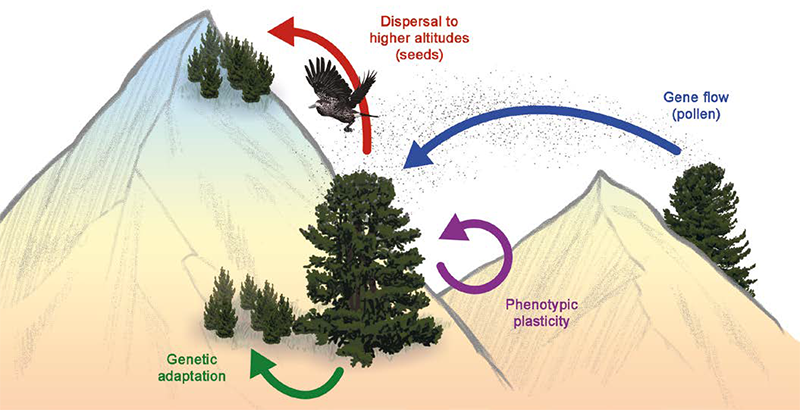
Fig. 9. The four ways in which the stone pine can respond to climate change. Phenotypic plasticity (purple), dispersal to higher altitudes (red), gene flow through pollen from lower-lying stands (blue) and genetic adaptation (green).
Not only the climate will continue to change, but also the utilisation of the stone pine habitats: where meadows and pastures are abandoned, forest can develop, something that benefits the Swiss stone pine. It should be noted that the reclamation of forest area above today's timberline is in fact reforestation, as the establishment of alpine pastures had often pushed the natural timberline down by 200–300 m. Elsewhere, intensified human activities (e.g. tourism, mountain farming) and high game pressure can have negative effects on natural regeneration.
Finally, longevity could also become a genetic stumbling block, because today’s old trees became well established in their youth about 150 years ago in wetter and much cooler conditions – because they were well adapted at that time. These trees continue to pass on their genes to new generations, but these need to prove themselves in a drier and warmer environment.
This assessment does not however mean that the Swiss stone pine is on the verge of extinction, and that the Swiss stone pine forest will disappear. It is possible, for example, that at lower altitudes of the Swiss stone pine occurrence, competition could decrease, especially from spruce, if the latter were to come under increased pressure from drought and bark beetles. The area colonised by Swiss stone pine could however become smaller. Especially in marginal areas, where the climate is already subject to very oceanic conditions, the Swiss stone pine is likely to struggle over the next one to two hundred years or even disappear in some places. On the other hand, there is growing interest in Swiss stone pine products and thus also in the silvicultural promotion of this species. In view of global warming, this promotion should focus on the high altitudes, where conditions suitable for Swiss stone pines will continue to prevail in the future.
Recommendations for forestry practice
In order to preserve stone pine forests as diverse habitats at the transition to the alpine zone under future climate conditions, an integrative approach is needed to protect biodiversity and the various functions and services provided by the forest, which include protection, utilisation and recreation. Local conditions and silvicultural history are important when assessing where and how to promote the Swiss stone pine. The two fungal pathogens snow blight (Gremmenia infestans, fig. 10) and Scleroderris dieback (Gremmeniella abietina) play a decisive role in the regeneration dynamics of Swiss stone pine and influence its spatial distribution.
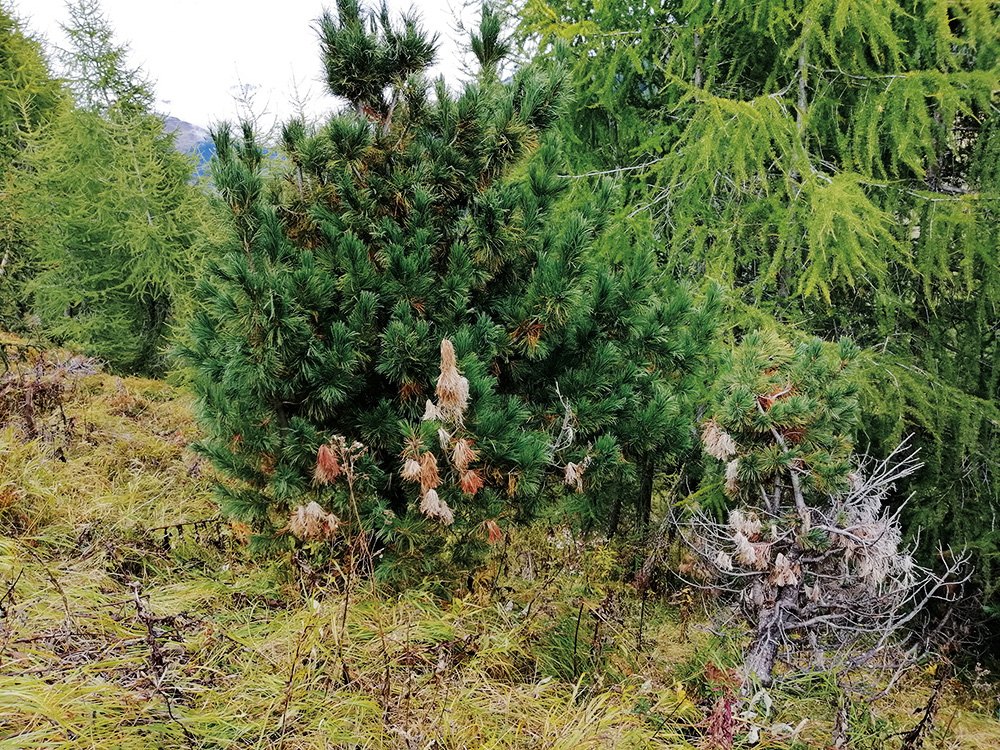
Fig. 10. Swiss stone pine infected with the snow blight (Gremmenia infestans) near the timberline. The larger tree on the left will cope with the infection. The smaller tree on the right is so badly infected that it will probably die in the next few years. Photo: Frank Krumm (WSL)
The Swiss stone pine prefers open forest structures (fig. 11). Although it is well adapted to mountain sites, a high stem density is a problem for the stone pine, especially in the shade of faster-growing tree species such as spruce. In order to preserve the Swiss stone pine even in the face of increasing competition, it should be promoted as early as possible through targeted tending of the young plants or later by removing competing species. In this way, the Swiss stone pine can also take on functions as a valuable mixed tree species even outside its predicted future distribution area, in the event that the spruce comes under increasing pressure there as a result of beetle damage.
When planting Swiss stone pines, attention should be paid to ensuring that:
- suitable small sites are selected; and that gullies and snowy depressions are avoided
- the trees are planted in small, well-spaced groups
- the trees are mixed with other high altitude tree species (e. g. Swiss mountain pine, larch)
- regional planting material in pots is used, taking into account a possible shift in altitude under future climate conditions
- where possible, the plants are bred at high altitudes (pre-adaptation)
- planting also above the current forest line is considered
Translation: Tessa Feller
Literature
Literature references can be found in the original publication (PDF).
You can order the printed WSL fact sheet Swiss stone pine – Portrait of a Mountain Forest Tree free of charge from WSL:
WSL e-shop
Zürcherstrasse 111
CH-8903 Birmensdorf
e-shop@wsl.ch
